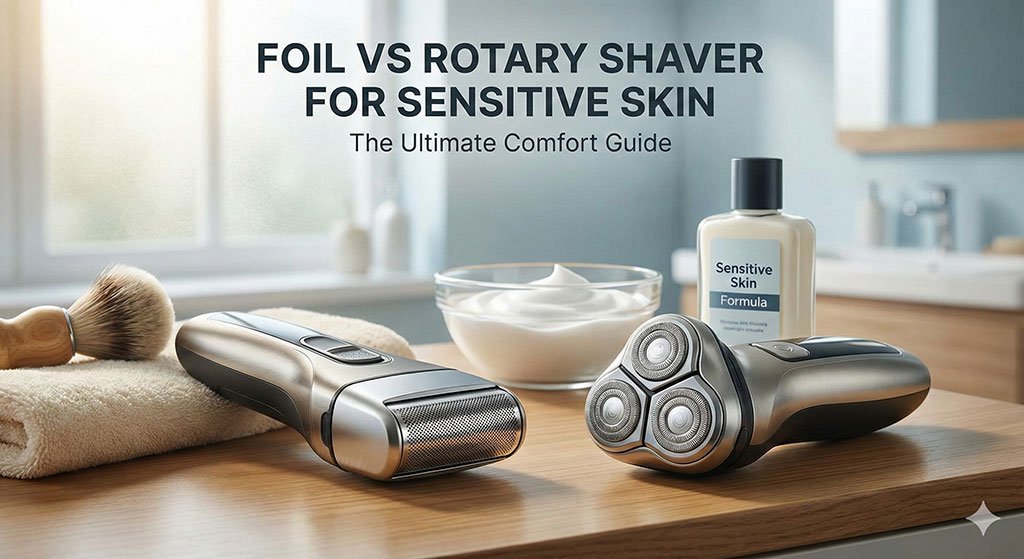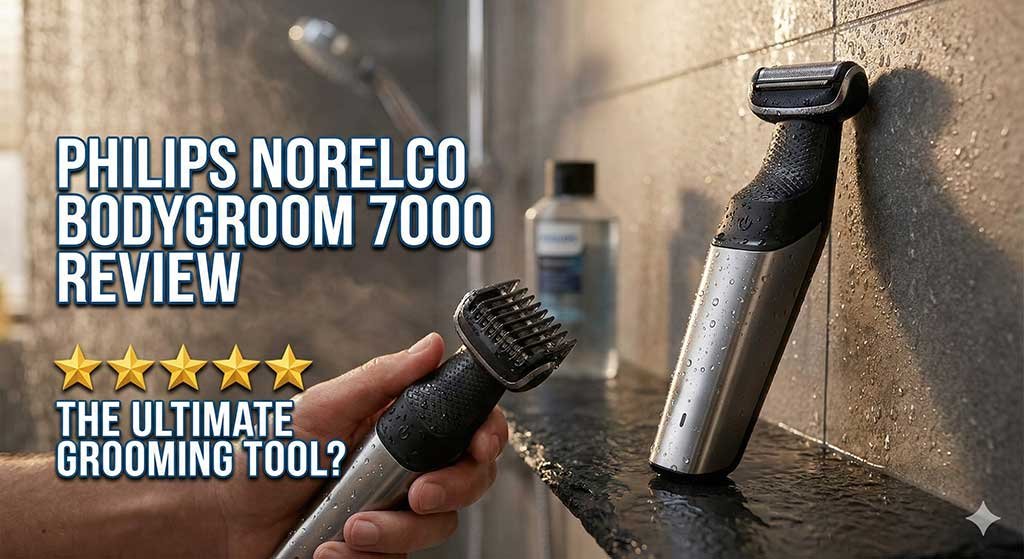Choosing the perfect steak knife can elevate your dining experience from ordinary to extraordinary. When you sit down to a beautifully cooked steak, you want a knife that glides through the meat, not one that tears it apart. This is where the great debate begins: serrated vs non-serrated steak knives. Which one is right for you? This comprehensive guide will walk you through all the key aspects, helping you make an informed decision for your kitchen.
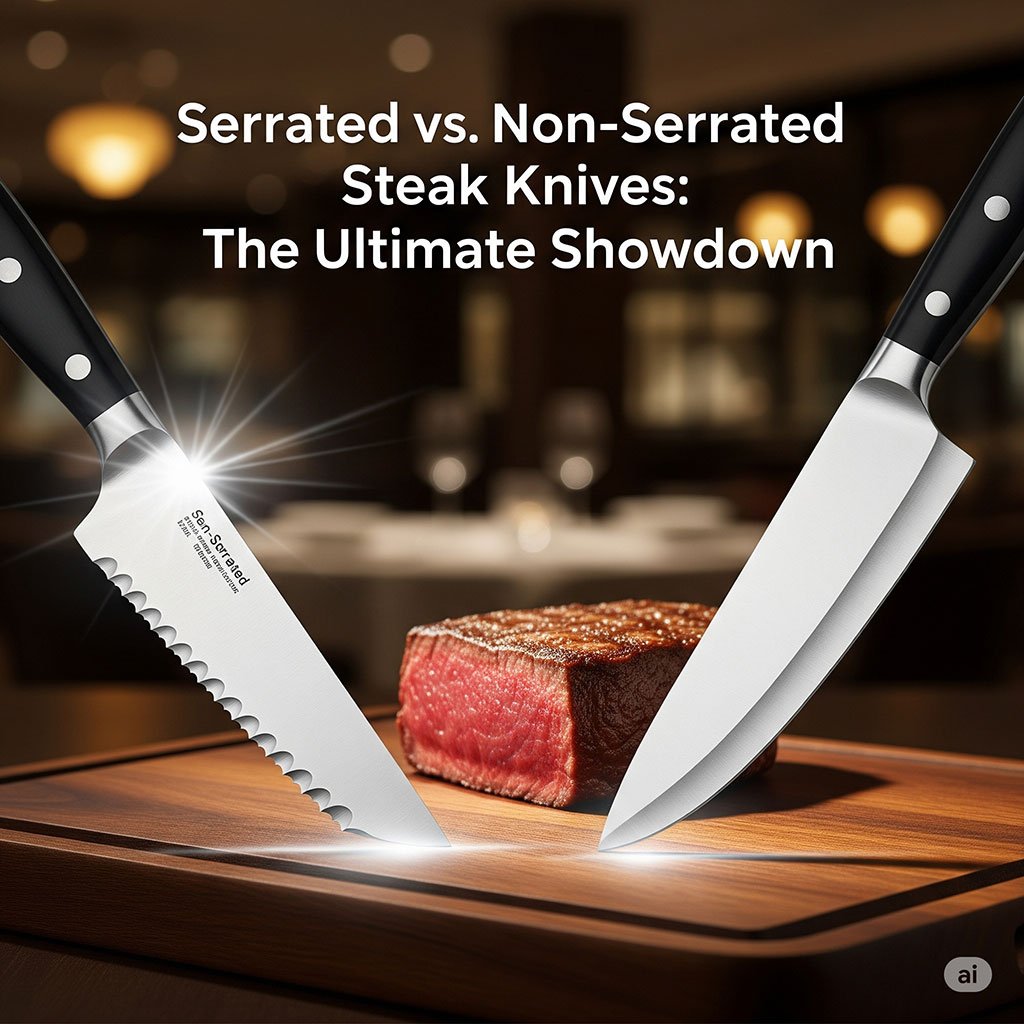
Table of Contents
Serrated Steak Knives: The Aggressive Cutter
A serrated steak knife is easily identified by its saw-like edge. These knives feature a series of teeth or scallops along the blade. This design isn’t just for show; it serves a specific purpose.
How Serrated Knives Work
The teeth on a serrated knife act like tiny saw blades. When you cut into a steak, the points of the serrations grip the surface. As you move the knife back and forth, the teeth tear through the meat fibers. This process allows the knife to cut through tough exteriors or crusts with minimal effort. Think of a well-seared steak or a piece of meat with a slight chew. A serrated knife powers through these textures with ease.
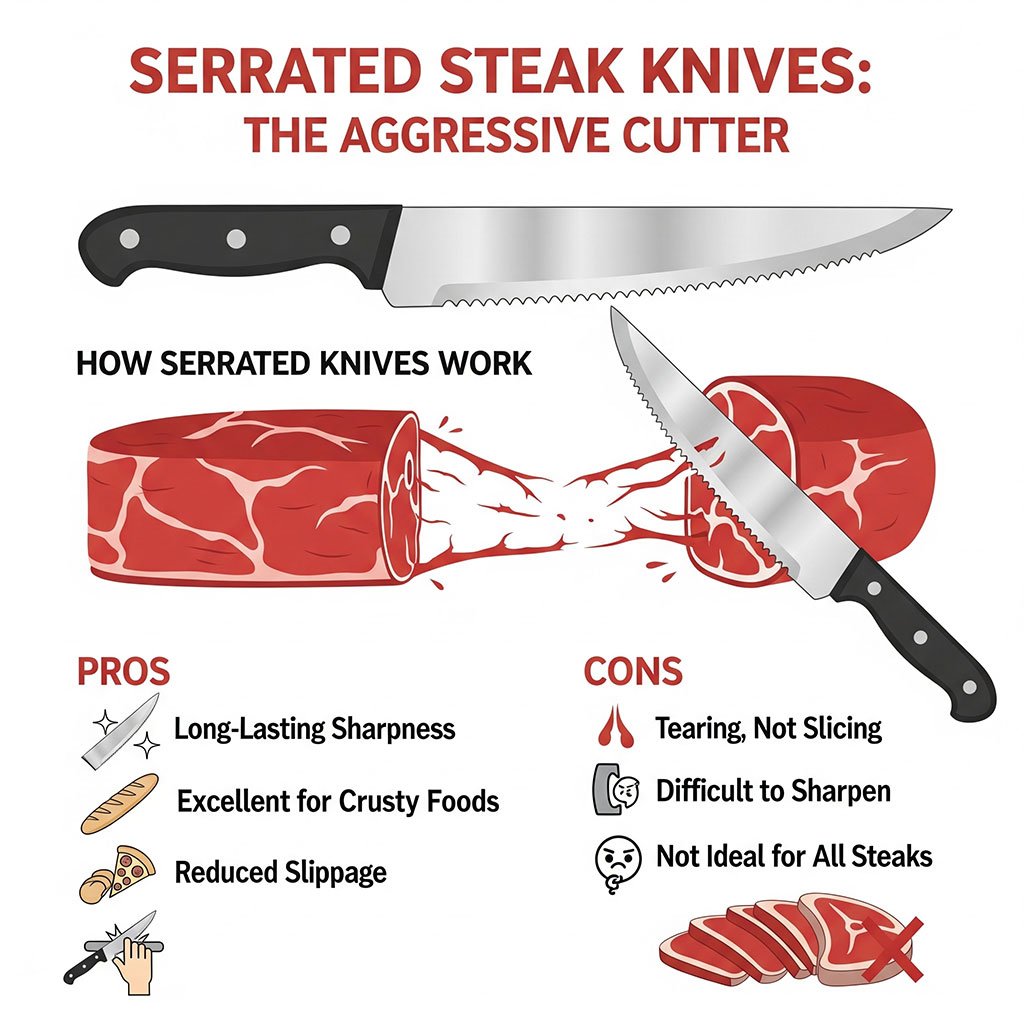
Pros of Serrated Knives
- Long-Lasting Sharpness: Serrated knives are famous for their ability to stay sharp for a very long time. The teeth bear the brunt of the cutting, and since only the tips of the serrations touch the cutting board, the main part of the blade remains protected. You won’t need to sharpen a serrated knife nearly as often as a non-serrated one. This makes them a low-maintenance option for busy households.
- Excellent for Crusty Foods: The saw-like action is perfect for foods with tough exteriors and soft interiors. Besides steak, a serrated knife is also great for cutting tomatoes, bread, or thick-skinned fruits. The serrations bite into the skin without crushing the soft insides.
- Reduced Slippage: The serrated edge provides excellent grip on the food surface. This makes the cutting motion more secure and less likely to slip, especially on slick or fatty pieces of meat.
Cons of Serrated Knives
- Tearing, Not Slicing: The biggest drawback of a serrated knife is the way it cuts. Instead of making a clean, smooth slice, it tears the meat fibers. This can lead to a messier-looking cut and may affect the texture of the steak. If you prefer a perfectly clean slice, a serrated knife may not be your best choice.
- Difficult to Sharpen: Sharpening a serrated knife is a complex task. You can’t use a standard knife sharpener. It requires a special tool, like a sharpening rod, to individually sharpen each scallop. This is a skilled job, and many people simply opt to replace the knife when it gets dull rather than attempt to sharpen it.
- Not Ideal for All Steaks: While great for some cuts, serrated knives can be overkill for very tender steaks like a filet mignon. The tearing action can ruin the delicate structure of the meat.
Non-Serrated Steak Knives: The Smooth Slicer
Non-serrated steak knives, also known as straight-edge steak knives, have a smooth, straight blade. They look much like a smaller version of a chef’s knife or paring knife.
How Non-Serrated Knives Work
A non-serrated knife works by applying downward pressure. The razor-sharp edge slices cleanly through the meat fibers. It relies on a very fine, sharp edge to achieve a precise cut. This method preserves the integrity of the steak, giving you a beautiful, clean slice every time. It’s all about the finesse of the blade and the sharpness of its edge.
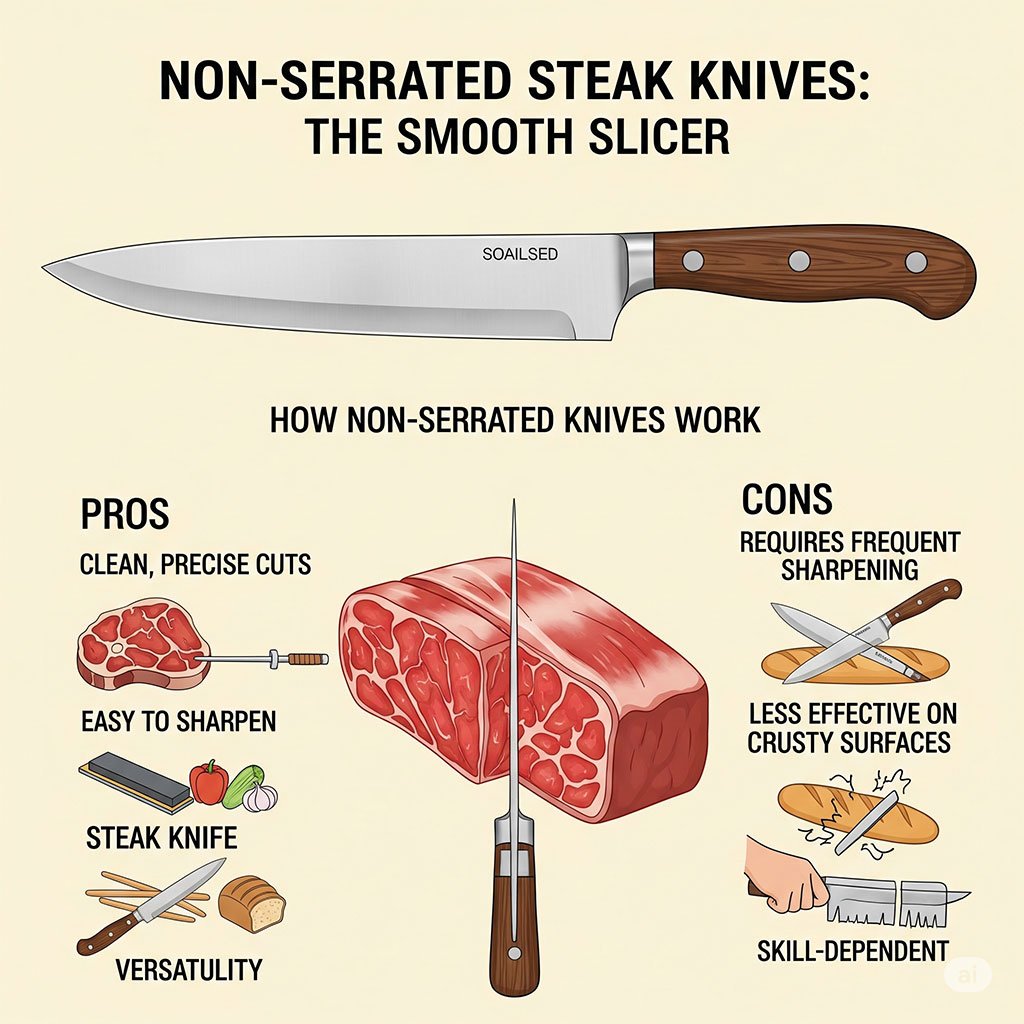
Pros of Non-Serrated Knives
- Clean, Precise Cuts: The primary advantage of a non-serrated knife is its ability to deliver a flawless cut. It glides through the steak, leaving a smooth surface. This is especially important for high-quality, tender cuts of meat where you want to appreciate the texture without any tearing. A clean slice also enhances the presentation of your meal.
- Easy to Sharpen: Sharpening a non-serrated knife is simple. You can use a whetstone, an electric sharpener, or a sharpening steel. This makes it easy to maintain a razor-sharp edge at home. Regular sharpening ensures your knife is always performing at its best.
- Versatility: A non-serrated steak knife is often more versatile. Its sharp, straight edge can be used for more than just steak. You can use it to slice other meats, vegetables, or even fruit, making it a valuable all-around tool.
Cons of Non-Serrated Knives
- Requires Frequent Sharpening: To maintain its effectiveness, a non-serrated knife needs to be sharpened regularly. The fine edge dulls more quickly, especially if you use it on hard surfaces or cut through bone. If you neglect sharpening, the knife will start to tear the meat, defeating its main purpose.
- Less Effective on Crusty Surfaces: The smooth blade can struggle with tough, crusty exteriors. It may require more force, and there’s a risk of the blade slipping. This can be a safety concern and can also crush the food.
- Skill-Dependent: Using a non-serrated knife well requires a bit more skill. You need to apply consistent downward pressure and use a smooth motion. A poor technique or a dull knife will lead to a messy result.
Serrated vs Non-Serrated Steak Knives: A Side-by-Side Comparison
To make your decision easier, here is a quick comparison table summarizing the key differences between the two types of steak knives.
Feature | Serrated Steak Knife | Non-Serrated Steak Knife |
Cutting Action | Sawing, tearing | Smooth slicing |
Best For | Tough, well-done steaks; meats with crusts | Tender, delicate cuts like filet mignon |
Maintenance | Low (rarely needs sharpening) | High (needs regular sharpening) |
Ease of Sharpening | Difficult, requires special tools | Easy, can be done at home |
Cut Quality | Messy, tears fibers | Clean, precise |
Versatility | Limited to specific tasks | More versatile for various foods |
Hybrid Option: Micro-Serrated Knives
You may have also heard of a third option: micro-serrated knives. These knives feature very small, fine serrations. They are designed to offer the best of both worlds. They provide some of the tearing action of a serrated knife but with a cleaner cut. They also stay sharp for a long time. However, they are still difficult to sharpen and don’t provide the same pristine slice as a true non-serrated knife. This type of knife is often a popular choice for those who want low maintenance but still want a better cut than a traditional serrated knife.
How to Choose the Right Knife for Your Needs
When it comes to the serrated or non-serrated steak knives debate, the right choice ultimately depends on your personal preferences and the type of steaks you typically enjoy.
- If you value convenience and low maintenance, and often eat steaks with a hearty crust, a serrated steak knife is likely the best choice for you. They are durable and ready to use whenever you need them.
- If you are a steak connoisseur who appreciates a clean, perfect slice and are willing to put in the effort to maintain a sharp edge, then a non-serrated steak knife will give you the superior cutting experience you desire.
- If you want a bit of both, a set that includes both types might be the perfect solution. Use the non-serrated knife for tender cuts and the serrated one for tougher, crustier meats.
Important Factors to Consider Beyond the Blade
While the blade type is crucial, other factors also contribute to a great steak knife.
- Handle Material and Ergonomics: The handle should feel comfortable and secure in your hand. Look for handles made from materials like wood, stainless steel, or composite. A good grip prevents hand fatigue and ensures better control.
- Blade Material: Most quality steak knives are made from high-carbon stainless steel. This material offers a great balance of sharpness, durability, and rust resistance.
- Balance and Weight: A well-balanced knife feels natural and effortless to use. The weight should be distributed evenly between the handle and the blade.
- Price: Steak knives come in a wide range of prices. You can find good quality sets at a reasonable price, but premium, hand-forged knives can be quite expensive. Consider your budget and how often you will use the knives.
FAQ
The main difference is the blade edge. Serrated knives have a saw-like edge that tears through meat, while non-serrated knives have a smooth, straight edge that slices cleanly.
Yes, serrated knives are generally better for tougher cuts with a crusty exterior. The teeth on the blade can grip and saw through the tough fibers more effectively than a smooth blade.
Serrated knives hold their edge for a very long time. While they don’t require frequent sharpening, they can be sharpened with a special tool. Most people find it easier to just replace them when they eventually get dull.
Yes, a sharp, non-serrated steak knife is quite versatile. It can be used for slicing other meats, vegetables, or even fruits. Its straight edge makes it a useful general-purpose tool.
For a tender, high-quality steak, a sharp non-serrated knife is the better choice. It will glide through the meat, preserving its delicate texture and providing a clean, elegant cut.
Many restaurants use serrated knives because they are durable and require very little maintenance. They stay sharp for a long time, which is a practical and cost-effective choice for a high-volume establishment.
A micro-serrated knife can be a good compromise. It offers the low maintenance of a serrated knife with a slightly cleaner cut. However, it still falls short of the precision of a non-serrated blade and is difficult to sharpen.
Final Words
So, when it comes down to it, the choice between a serrated and a non-serrated steak knife is all about what you prefer and how you like to enjoy your meal. Serrated knives are fantastic if you want something that’s easy to take care of and can power through a tough crust. On the other hand, a non-serrated knife gives you that perfect, clean slice for a truly elegant dining experience. In the end, the best steak knife for you is the one that simply makes you happy and makes that great steak taste even better.

